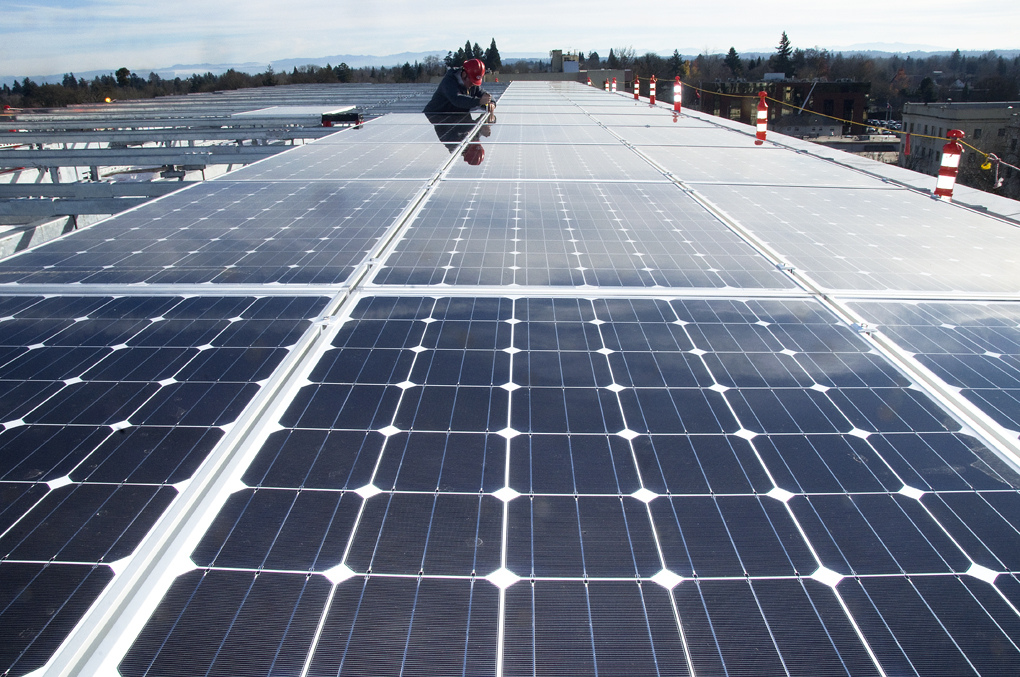Lawmakers in Oregon are poised to decide on the Oregon Clean Energy Jobs Bill, a move to either fulfill long-held global warming commitments or press pause yet again. Policymakers might get cold feet; the usual corporate stall tactics are rolling in. But what do people in Oregon think?
Oregon is a state often divided by urban-rural, partisan, and bigger geographical lines (take opinions on sanctuary cities, DACA, and healthcare). But on climate change, Oregonians look to be unified behind solutions. Opinion modeling by the Yale Program on Climate Change Communication shows that 76 percent of Oregonians want to see CO2 regulated as a pollutant, including 60 percent of Oregon Republicans. And a recent statewide survey found that Oregon voters support a cap-and-invest program, like the legislation under consideration, by a three-to-one ratio.
72% of @PortlandGeneral customers support the goal of generating 100% of #Oregon’s electricity from #renewables by 2030.
Portland General Electric (PGE) has voiced opposition to the legislation, so it’s worth looking at PGE customer attitudes more specifically. And it looks like PGE customers would prefer PGE live up to its promises rather than put up roadblocks. One statewide survey* last summer found that:
- 68 percent of PGE customers said it’s important to them (either “extremely” or “very” important) that their electric utility “provides power produced from clean, renewable sources.”
- A majority of Oregonians (57 percent) said they “would prefer to pay a little bit more to ensure that more of my electricity is coming from clean, renewable sources like solar, wind, and hydroelectricity” vs. 35 percent who said they “would prefer to keep paying the same rates for electricity, even if it means I won’t receive more electricity from clean, renewable sources.” (The remaining share was undecided.)
Another recent survey found:
- 72 percent of Oregonians who are PGE customers support (54 percent “strongly”) the goal of Oregon generating 100 percent of its electricity using clean, renewable sources like wind, solar, and hydropower by 2030. Only 21 percent were opposed.
- The same share—72 percent (47 percent “strongly”)—say they support requiring all new sources for generating electricity to be clean and renewable as a means to increase Oregon’s use of renewable energy and reduce its use of natural gas to generate electricity. Twenty-two percent were opposed to this idea.
On climate questions more broadly, it’s fair to say there are partisan and geographical differences. But taking a look again at Yale’s climate opinion maps (a statistical model that aggregates scores—and several years’ worth—of national and local public opinion polls and can estimate state, congressional district, and county attitudes with around 95 percent confidence), we see that in every county across Oregon, sizable majorities want CO2 regulated as a pollutant. Morrow County shows the lowest level of support, but it still stands at 64 percent. Every other county shows support closer to 70 percent, with a few above 80 percent.
In *every* county across #Oregon, sizable majorities want CO2 regulated as a pollutant. #orleg #ActOnClimate
And the pattern holds in each Congressional district. On the east side of the state, in District 2, 71 percent of voters favor regulating CO2 as a pollutant. Along the coast, support is high: in District 4 it’s 75 percent (Oregon’s southwest corner); in District 1 it’s 76 percent; and in District 5 it’s 74 percent. In District 3, which includes most of Portland, support bumps to fully 81 percent. Support does drop among conservative voters, but still, majorities of Oregon Republicans—with numbers hovering just above or below 60 percent—in each of Oregon’s Congressional districts support regulating CO2 pollution.
The statewide survey referenced above, conducted by PolicyInteractive, reaffirms these numbers. Overall, 77 percent of Oregonians say there’s solid evidence global warming is happening (with less than a quarter still citing “natural causes” over “human”), with only 4 percent saying it’s a “hoax.”
Oregonians are seeing climate impacts close to home, and their views are changing accordingly. Nearly 8 in 10 (78 percent) agree that Oregon’s shrinking glaciers and decreasing snowpack are caused by climate change. Slightly lower but strong majorities say climate change worsens hurricanes and forest fires.
As PolicyInteractive’s Tom Bowerman points out, “Oregon voters support climate action now at a 5:1 ratio.” In a forced choice, 77 percent chose the statement “Climate change requires us to change our way of life such as driving less or living more simply” as opposed to just 14 percent who chose “If climate change becomes a problem we can deal with it later.” Only 9 percent were undecided.
As mentioned, 61 percent of Oregon voters support a cap-and-trade program similar to those enacted by California and Canadian provinces—and similar to the legislation on the table in Salem. Eighteen percent say they are opposed to such a measure, and 22 percent were undecided. Again, political party differences shape responses on this question: 80 percent of Democrats favor a cap-and-trade policy; Republicans were split, with 35 percent support and 38 percent opposition; 50 percent of non-affiliated or third party voters support it. There is a preference for reinvesting cap-and-trade revenue to cut pollution over refunding the money to taxpayers.
Oregonians across the political spectrum and across the map may not see eye to eye on all the issues of the day, but on climate change, Oregon voters’ values—including those of PGE’s customers specifically—are clear as day.
*These polls have not been publicized, but the organizations that commissioned them agreed to share some of their findings for this article.


Comments are closed.